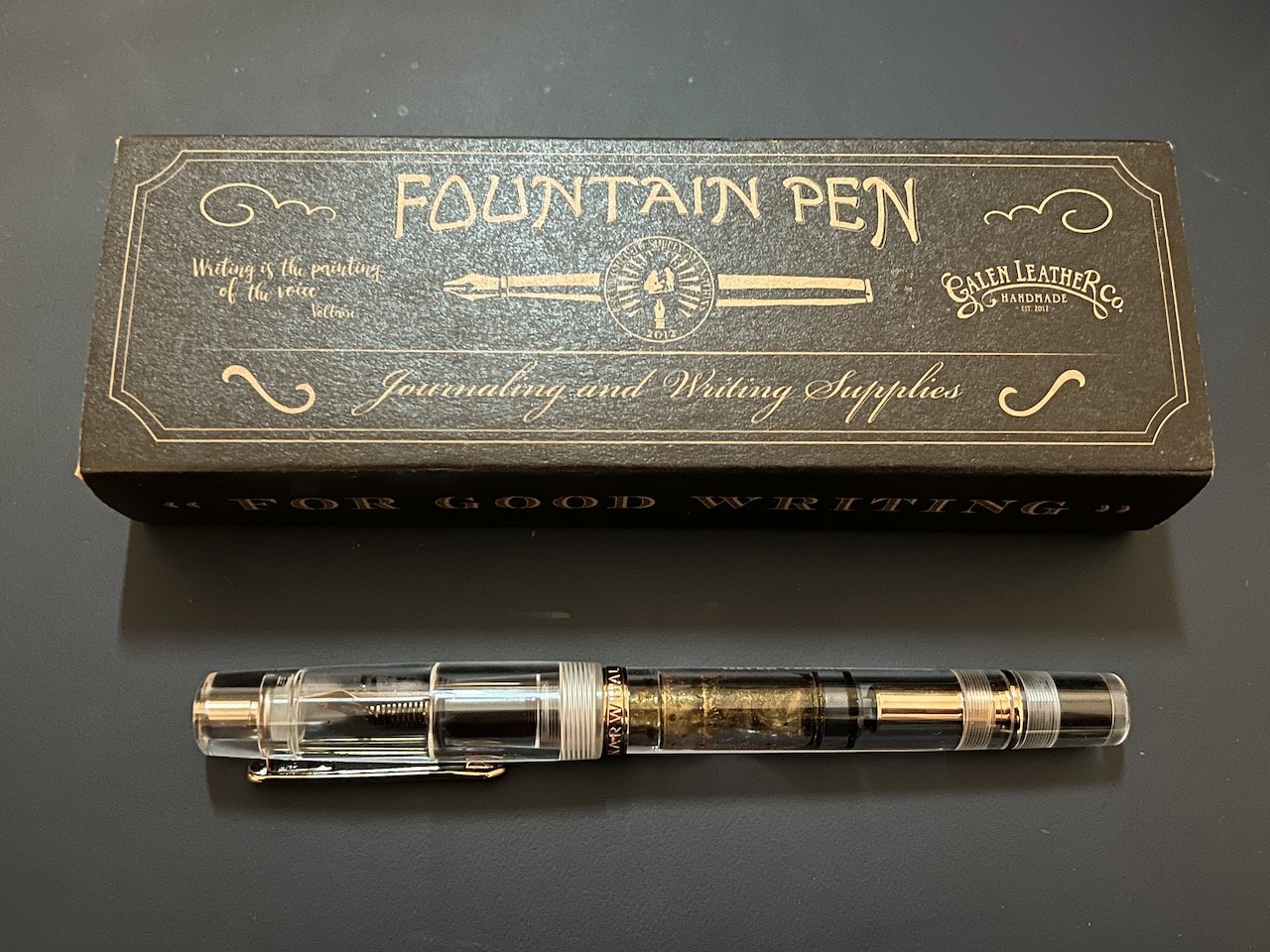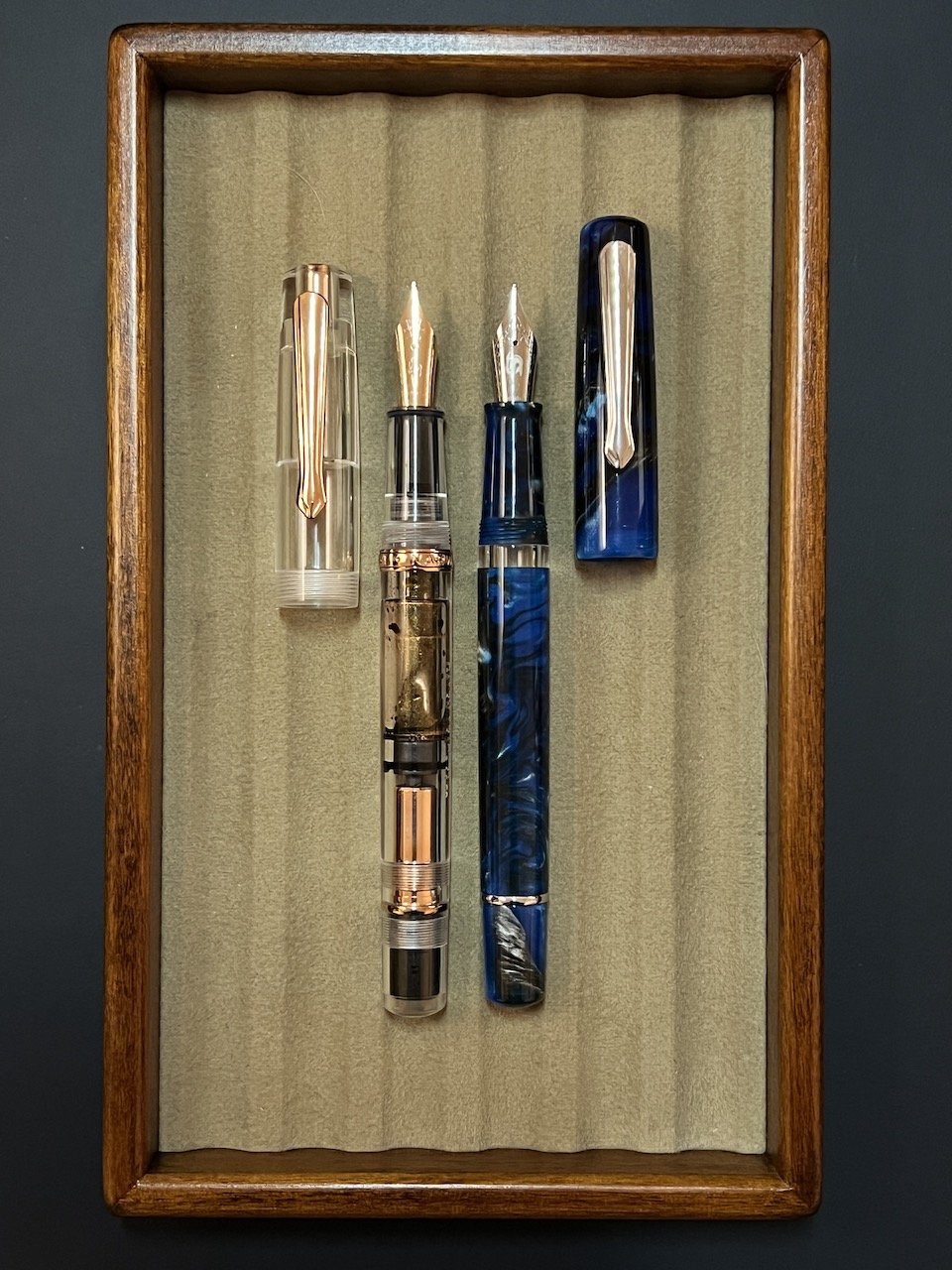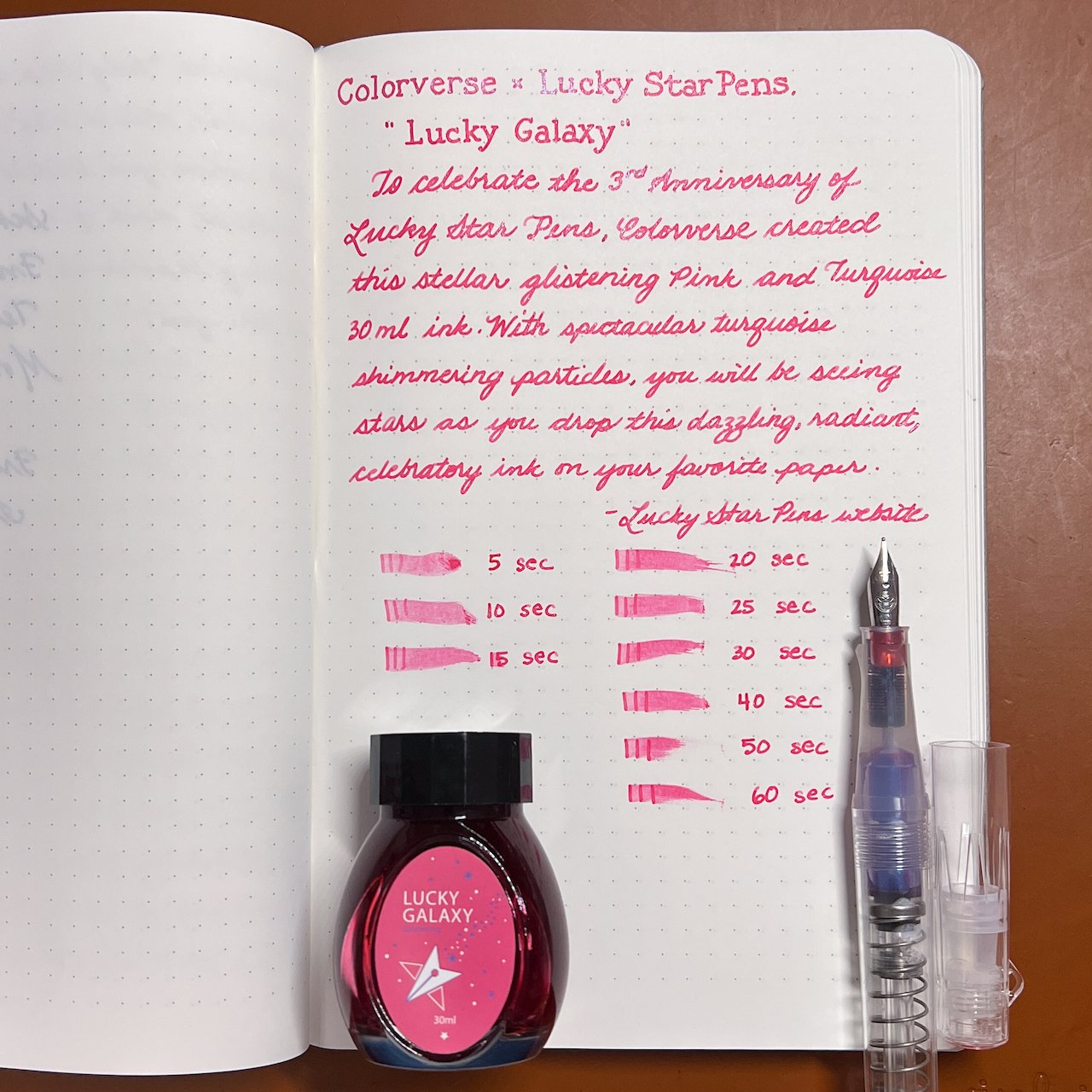(Kimberly (she/her) took the express train down the fountain pen/stationery rabbit hole and doesn't want to be rescued. She can be found on Instagram @allthehobbies because there really are many, many hobbies!.)
I usually don’t know what is going to show up in Brad’s boxes of goodness but I was excited to find a Galen Leather Co. pen box that contained a pen with rose gold accents! I don’t know when it happened but at some point in my adult life, I started loving rose gold, as much or even more than yellow or white gold. This happened even before my obsession with fountain pens. So whenever a fountain pen has rose gold trim, I’m in trouble!
Up for review is the Nahvalur x Galen Leather Demonstrator fountain pen with Rose Gold trim. Nahvalur, formerly Narwhal Pens, made a demonstrator version of their popular Nahvalur Original piston-filler fountain pen with rose gold trim and nib to celebrate Galen Leather’s 10th anniversary. This Demonstrator model is also very similar to their Schuylkill pen. Side bar: how long do we have to keep saying “Nahvalur, formerly Narwhal Pens? Seems like it’s been forever, but only since August 4, 2022, so I think I’m going to let it go until August 3rd, 2023, and after that, it’s Nahvalur and nothing else, lol!
Similar in size and shape the Demonstrator has the added barrel band and of course, doesn’t have an ink window. It is also a little heavier than the Schuykill.
The pen comes with a rose gold-colored steel nib with the Nahvalur logo, in Fine, Medium, Broad, Double Broad and Stub (though it looks like only the Broad and Stub nib sizes are in stock right now). In addition to the nib, the rose gold accents include the clip, the piston, the piston ring, and the barrel band, which still reads “Narwhal”. The acrylic is polished well and is very clear and shiny.
Love the logo on the nib, though I wish it would indicate the nib size somewhere.
Since I was reviewing a new pen, I probably should have done the smart thing and inked it up with a “normal”, well-behaving ink, but the rose gold matchy match was calling my name, so I picked Vinta Inks’ The Maiden/Lakambini, from the Fairytale Collection. But it turns out there was no need to worry. The ink behaved just fine in the pen and wrote beautifully. It’s fun to look at the shimmer in the pen barrel and in the writing as well. As with all shimmer inks, to prevent clogging, periodically tilt the pen up and down so that the shimmer particles don’t all settle into the nib/feed. What I like to do with piston fillers, but also with converters, is to use the piston to push the ink up into the feed and then retract the piston to “suck out” the ink and any shimmer that may have accumulated on the feed. It helps ensure that you don’t end up with a pen that is clogged with shimmer or end up with no shimmer left because it’s all been written up earlier.
Writing sample on Clairefontaine Triomphe.
Almost too sparkly to read on the Clairefontaine.
Tomoe River 68 gsm Endless Recorder notebook.
Look at all this fun shimmer in the pen! And you can almost see the engraved “Galen Leather Co” on the barrel.
The Lakambini ink is pink with gold shimmer, which makes it look a bit brownish, especially with wet and broad nibs. The ink has average dry time, but still pretty good considering this is a medium nib which lays down a somewhat broad line. You can see in the chromatography above that it breaks down into pink (of course), along with some yellow and blue. I still don’t think I could figure out what an ink looks like if you just gave me a chromatography strip though!
The closest match would be Tono & Lims Burma Tourmaline. However Robert Oster’s Rose Gilt Tynte is also similar but with a silver shimmer instead of gold. Sailor Peche is a brighter pink without shimmer. I also included some other inks that are somewhat in the same range.
L to R, Top to Bottom: Robert Oster Rose Gilt Tynte, Vinta Lakambini, Tono & Lims Burma Tourmaline, Sailor Peche, Robert Oster Rose Gold Antiqua, Robert Oster Cherry Blossom, Robert Oster Australis Rose, Papier Plume Garden District Azalea.
I’ve had this pen inked up since Dec. 20, 2022, and have used it about 8-9 times in that time frame. I have deliberately left it untouched for a few weeks at a time, and whenever I did so, it might take a stroke or two for it to start writing but then it writes flawlessly after that. Hard to say whether this is due to the ink or the pen/cap, but I didn’t really see it as much of a problem.
Cleaning the pen is pretty easy: you can either use the piston to get water in/out of the barrel or you can unscrew the nib unit and syringe clean it. Just be careful not to blast it too hard or you may get water behind the piston. If that’s the case, you can also disassemble the pen, with a Nahvalur wrench (not included with this pen). I was unable to fit either of my TWSBI wrenches to fit the piston but I have heard that it can work.
L to R: Pelikan M605, Pilot Custom Heritage 912, Platinum 3776, Nahvalur, TWSBI 580 & Eco (you knew those two were coming.)
The pen sells for $59 USD on the Galen Leather website and also includes a free leather pen sleeve. This is a great price for a pen that looks great and performs well too. It is similar in price to a TWSBI 580 AL/ALR and I would say a fairly comparable pen. The Vinta Lakambini ink can be found at Vanness Pens starting at $4/sample or $16 for a 30 ml bottle. This was a great match for this pen and I plan on buying a bottle after I’ve used up this sample.
(Disclaimer: Thank you to Galen Leather for sending us this pen and to Vanness Pens for the Vinta Ink. All other items in this article are my own.)
Enjoy reading The Pen Addict? Then consider becoming a member to receive additional weekly content, giveaways, and discounts in The Pen Addict shop. Plus, you support me and the site directly, for which I am very grateful.
Membership starts at just $5/month, with a discounted annual option available. To find out more about membership click here and join us!








































